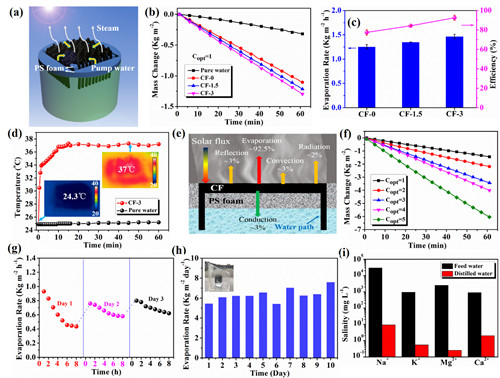Solar energy as a clean and sustainable green energy has become the focus of energy conversion and utilization in recent years, and has been widely used in photovoltaic power generation, photocatalysis and photothermal conversion. Among them, the use of photothermal conversion principle for seawater desalination is a low-cost, low-maintenance seawater desalination technology. Current photothermal conversion materials mainly include carbon-based materials, plasmon materials and semiconductor materials. Due to their own physical and chemical stability, the above materials are subjected to extreme environments such as high salt mist, high temperature, high humidity and high corrosion There are application limitations, such as the separation and purification of multi-media such as high-saline seawater (10wt%), brackish water, strong polar organic solvents, oil-water emulsions, etc.
In order to solve the above problems, Liu Fu, a researcher of the Advanced Functional Membrane Team at the Ningbo Institute of Materials Technology and Engineering, Chinese Academy of Sciences, designed and prepared a carbon fiber material with ultra-stable environmental resistance for use in multi-media purification of photothermal conversion. The research team introduced a stable carbon layer on the surface of the carbon fiber through hydrothermal synthesis technology to improve the surface roughness. The specific surface area was increased to 0.5m2g, and the light absorption at a wavelength of 200-2500nm was increased from 89% to 97% before modification; and In the process of carbonization modification, some polar functional groups are introduced, the surface polarity of the modified carbon fiber is increased, and the polar surface energy is increased to 20mM / m, so that the carbon fiber can rely on the capillary force between the fibers to the liquid (water or organic solvent ) Self-extraction does not require additional extraction materials, which simplifies the design of solar evaporation devices. The woven carbon fiber layer can be used directly as a water absorption and light-to-heat conversion layer for purification of various media.
The experimental results show that the photothermal conversion efficiency of carbonized modified carbon fiber can reach 92.5%, the photothermal conversion rate of seawater under a standard sun reaches 1.47Kgm-2h-1, and the photothermal conversion rate under five standard suns It is ~ 5.86Kgm-2h-1, and has a long-term stable desalination effect on high-salt seawater (simulated Dead Sea seawater, salt concentration 10wt%). The carbon fiber distiller operates continuously for 10 days outdoors, and the daily water production is stable at ~ 7Kgm- 2. Maintain stable mechanical strength. Due to the rich multi-stage fiber structure of the carbon fiber and good capillary water absorption capacity, it has good dissolution and self-repairing ability for the crystallization of high-saline seawater on the fiber surface. The salt precipitated on the surface of the carbon fiber will re-dissolve after standing overnight Into the sea water, so as not to affect the photothermal conversion effect of carbon fiber. In addition, the modified carbon fiber has a good removal effect on oil-in-water emulsion (non-volatile silicone oil), the content of silicone oil in water can be reduced from 10000ppm to 11.9ppm; it can be used for organic solvents containing dyes such as dimethylacetamide in the printing and dyeing industry Purified, showing good decolorization and purification effect, the dye removal rate reaches 99.99%, the evaporation rate is 0.98Kgm-2h-1, and can withstand long-term strong polar organic solvent dimethylacetamide (soak for 10 days), Its mechanical strength does not change.
The above results indicate that the carbonized modified carbon fiber material has broad application prospects in the field of multi-media purification, such as high-salt seawater desalination, organic solvent decolorization, oil-water emulsion deoiling, etc., which greatly expands the current carbon fiber and photothermal conversion materials in solvent purification. Application areas. The result was published in Journal of Materials Chemistry A (DOI: 10.1039 / c8ta08829b) under the title of Ultra-robust carbon fibers for multi-media purification via solar-evaporation. PhD student Tiantian Li and associate researcher Fang Qile are co-first authors of the paper, and Liu Fu is the corresponding author of the paper.
The above research work was supported by the National Natural Science Foundation of China (51673209, 5161101025), the Youth Promotion Association of the Chinese Academy of Sciences (2014258), and Ningbo Science and Technology Bureau (2014B81004, 2017C110034). Chen Youmei, a researcher in the Specialty Fiber Division of the Ningbo Institute of Materials, and Xi Xian, a doctoral student, supported the work.

Figure 1 Photothermal conversion performance of carbonized modified carbon fiber

Figure 2 Purification performance of carbonized modified carbon fiber for oil-in-water emulsion and dye-containing organic solvent
Water Reducer mainly is used for cement in construction field. Used for and widely for self-cured, vapor-cured concrete and its formulations. At the early stageof application, extremely prominent effects are shown. As the result, the modulus and site utilization can be drastically, the procedure of vapor cure is omitted in peak-heatsummer days. Statistically 40-60 metric tons of coal will be preserved when a metric ton of the material is consumed.The new raw material is researched and produced by ourselves, which is mainly used in theproduction of polycarboxylate superplasticizer products.
Remarkable plasticity: as a condition of blending where amount of cement and collapsibility are fixed aforehand, mixing water can be decreased by 18-28% when it is admised with reinforced concrete at 0.5-1.0%. Ststistically, compression strendth on the 1st day, the 3rd day and the 28th day after single application is increased by 60-90% and 25-60% respectively when it is added at standard blend dosage. As the result, compression strength, tensile strength, bucking strgth and modulus of elasticity will be improved to some extent.
*Related Products:water clarifer,water reducers for concrete.
Water Reducer
Water Reducer,Sodium Polynaphthalene Sulfonate,Sodium Naphthalene Sulfonate,Concrete Water Reducer
SJZ Chenghui chemical co ltd , https://www.chenghuichemicals.com